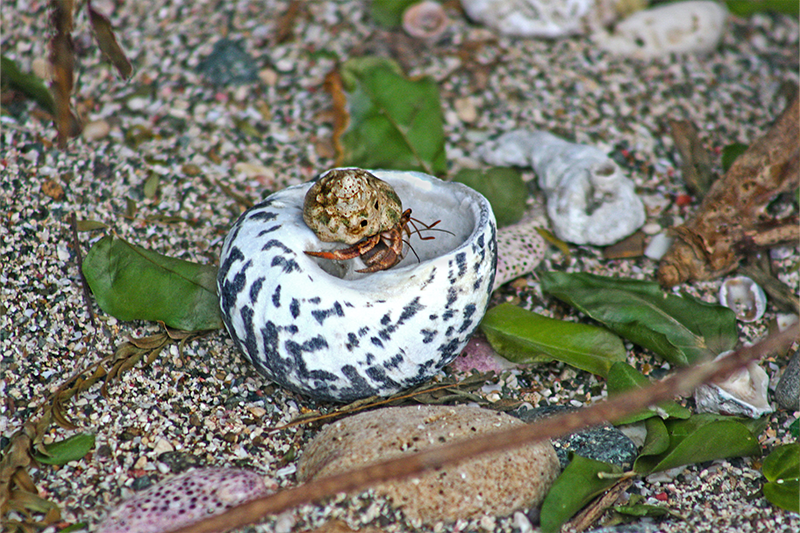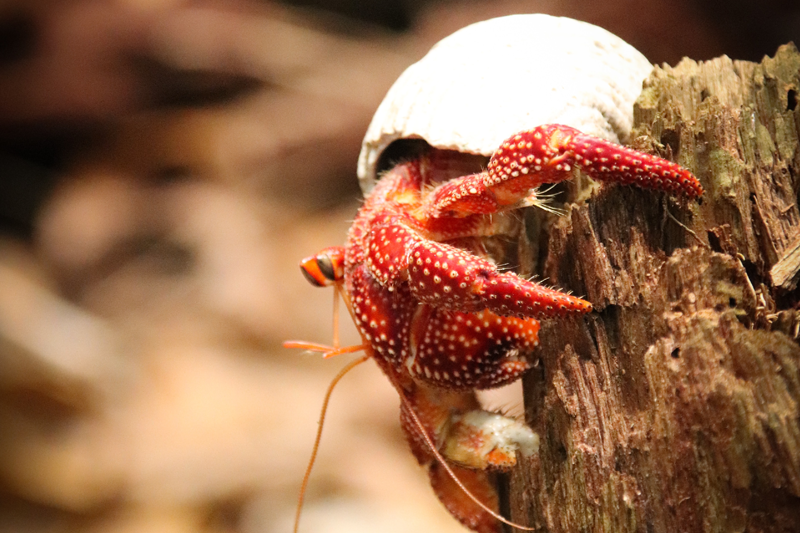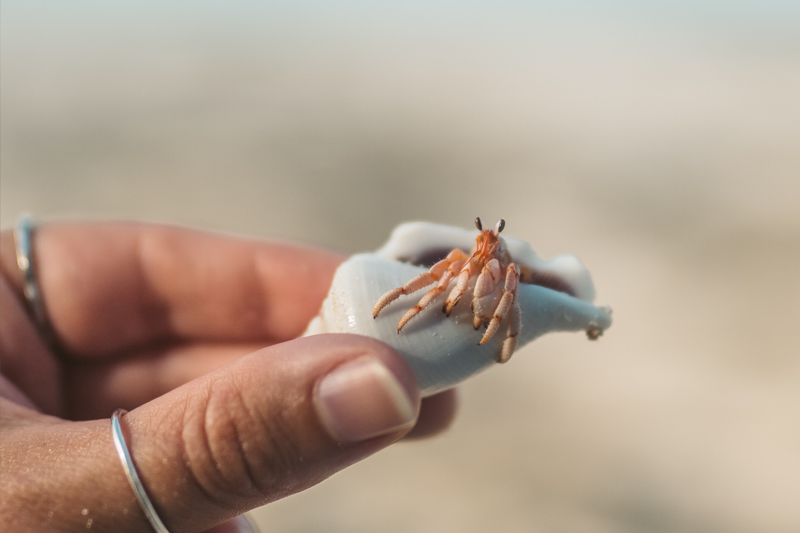Having your first hermit crab is exciting and daunting at the same time. Why? Because Hermit Crabs are not like cats & dogs that you can pick up and play with. Additionally, you can’t just leave them anywhere in your house just like what you can do with cats and dogs! And they also require a lot in their habitat and not providing this can be detrimental on your hermit crab’s health and life span.
So on this article we will be covering the things that you should take note of before and after you get your first hermit crab.
Here are some important things to do first:
- Set up the habitat: Hermit crabs need a properly sized tank, substrate, hiding places, and climbing opportunities. A 10-gallon tank is recommended for two small hermit crabs. The substrate should be at least 3 inches deep of a mix of sand and coconut fiber. Provide hiding places like coconut shells, PVC pipes, or driftwood, and climbing opportunities like rocks and branches.
- Provide proper heat and humidity: Hermit crabs require a warm and humid environment. The temperature should be between 75-85°F, and the humidity should be between 70-80%. You can use a heat mat, a heat lamp, or a combination of both to maintain the temperature. A hygrometer and a thermometer are necessary to monitor the temperature and humidity levels.
- Offer a variety of food: Hermit crabs are omnivores, and they need a balanced diet. Offer them a mix of commercial hermit crab food, fresh fruits and vegetables, and protein sources like cooked chicken, shrimp, or fish. Provide a calcium source like crushed eggshells or cuttlebone to promote healthy molting.
- Avoid handling: Hermit crabs are fragile creatures, and handling them can cause stress and injury. Instead, observe them from a distance and provide them with a quiet and peaceful environment.
- Research and learn: Hermit crabs are complex creatures with specific care requirements. Read books and articles, join online communities, and consult with experienced hermit crab owners to learn more about their behavior, care, and health issues.
Remember that hermit crabs can live for several years, and they require proper care and attention to thrive. With patience and dedication, you can provide a happy and healthy home for your new pets.
What are the stuff I should look out for in choosing a hermit crab?

Choosing a healthy hermit crab is important to ensure that it has the best chance of thriving in its new home. Here are some things to look out for when choosing a hermit crab:
- Activity level: Look for a crab that is moving around and exploring its environment. A crab that is hiding or not moving may be sick or stressed.
- Shell condition: A healthy hermit crab should have a shell that is not cracked or damaged. The shell should fit the crab’s body properly, with the opening not too small or too large.
- Eye and antenna health: The hermit crab’s eyes and antennae should be clear and not damaged or missing.
- Leg health: All of the hermit crab’s legs should be present and moving freely. A crab with missing legs may have been injured or attacked by another crab.
- Weight: A healthy hermit crab should feel heavy and full, indicating that it has been eating well.
- Behavior with other crabs: If you plan on keeping multiple hermit crabs, observe how the potential new crab interacts with others in the store. Choose a crab that is not aggressive or picking fights with other crabs.
- Source: Choose a crab from a reputable pet store or breeder. Avoid buying crabs from places like souvenir shops, as these crabs are often taken from the wild and may not have been cared for properly.
By looking for these signs of health, you can choose a hermit crab that has the best chance of thriving in its new home. Remember to provide proper care, a suitable environment, and plenty of love and attention to help your hermit crab lead a happy and healthy life.
What food are they allowed to eat?
Hermit crabs are omnivores and require a balanced diet of both plant and animal matter. Here are some foods that are safe and healthy for hermit crabs to eat:
- Commercial hermit crab food: A good quality commercial food should be the main staple of your hermit crab’s diet. Look for a brand that contains a mix of pellets, grains, fruits, and vegetables.
- Fruits: Hermit crabs can eat a variety of fresh or dried fruits, such as apples, bananas, mangoes, papayas, and berries.
- Vegetables: Vegetables are also an important part of a hermit crab’s diet. Some good options include carrots, cucumbers, kale, spinach, and sweet potatoes.
- Protein: Hermit crabs need protein to grow and molt properly. Cooked chicken, turkey, fish, and shrimp are all good sources of protein.
- Calcium: Hermit crabs require calcium to build their shells and maintain their health. Offer crushed eggshells or cuttlebone to provide a source of calcium.
- Treats: You can also offer occasional treats like mealworms, crickets, or dried shrimp. However, these should not be the main part of your hermit crab’s diet.
It’s important to provide a varied diet and rotate the food regularly to ensure that your hermit crab is getting all of the nutrients it needs. Avoid giving your hermit crab processed or sugary foods, as these can be harmful to their health. Always make sure that any food you offer is fresh, clean, and free from pesticides or other harmful chemicals.
What can I include in their habitat?

Creating a suitable habitat for your hermit crab is important for their health and well-being. Here are some things you can include in their habitat:
- Substrate: Hermit crabs need a substrate that is deep enough to burrow in and provides good moisture retention. A mix of sand and coconut fiber or sphagnum moss is a good option.
- Shelter: Hermit crabs need places to hide and feel secure. You can provide them with coconut shells, PVC pipes, or other suitable hiding spots. Make sure that the hiding places are big enough to fit your hermit crab comfortably.
- Climbing structures: Hermit crabs love to climb, so providing them with structures like rocks, branches, and driftwood can help keep them active and entertained.
- Water dish: Hermit crabs need access to both freshwater and saltwater. You can provide them with two dishes, one for freshwater and one for saltwater. Make sure to change the water regularly and use dechlorinated water.
- Heat and humidity sources: Hermit crabs need a warm and humid environment to thrive. You can use a heat mat, heat lamp, or both to maintain the temperature between 75-85°F and humidity between 70-80%.
- Calcium sources: Hermit crabs need calcium to build their shells and maintain their health. You can provide them with crushed eggshells, cuttlebone, or calcium sand to help supplement their diet.
- Toys and decorations: You can also include toys and decorations like seashells, fake plants, or other suitable items to make the habitat more interesting and stimulating for your hermit crab.
Remember to clean and maintain the habitat regularly to prevent bacterial growth and ensure that your hermit crab has a clean and healthy environment.
Things to avoid that I should take note of?
When setting up a habitat for your hermit crab, there are several things to avoid to ensure their health and safety. Here are some things to take note of:
- Avoid small habitats: Hermit crabs need plenty of space to move around and explore. Avoid habitats that are too small or do not provide enough room for your hermit crab to move around comfortably.
- Avoid painted shells: Do not provide your hermit crab with painted shells, as the paint can be toxic and harmful to their health.
- Avoid toxic materials: Make sure that all materials used in the habitat are non-toxic and safe for your hermit crab. Avoid using plastics, treated woods, or materials that may contain harmful chemicals.
- Avoid drafty areas: Hermit crabs need a warm and humid environment to thrive. Avoid placing the habitat in areas that are too drafty or expose your hermit crab to direct sunlight.
- Avoid over-handling: While hermit crabs can be fascinating pets, they are sensitive animals and can become stressed if handled too frequently. Avoid handling your hermit crab too often and always make sure to handle them gently and carefully.
- Avoid sudden changes: Hermit crabs are sensitive to changes in their environment, so it’s important to make changes slowly and gradually. Avoid sudden changes in temperature, humidity, or diet, as these can be stressful for your hermit crab.
- Avoid overcrowding: Hermit crabs are social animals, but they also need their own space. Avoid overcrowding the habitat with too many hermit crabs, as this can lead to stress and fighting.
By avoiding these common pitfalls, you can create a safe and healthy habitat for your hermit crab, helping them thrive in their new home.
